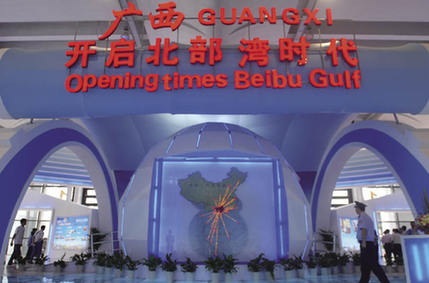| The export-oriented Pearl River Delta (PRD) in South China is suffering under the financial crisis that has swept across the world. Both enterprises and local governments have come to the conclusion that the only solution is to strengthen regional cooperation within the Pan-PRD (PPRD) area and expand the domestic market.
Cooperating for Recovery in the Pan-Pearl River Delta
By staff reporter LU RUCAI
 |
|
The Fifth PPRD Regional Coorperation and Development Forum and Trade Fair was held in Nanning, Guangxi in June 2009. China Foto Press |
THE onset of the global financial crisis has made cooperation among PPRD members an imperative," asserted Li Jinzao, vice chairman of Guangxi Zhuang Autonomous Region. Nanning, Guangxi's capital, hosted the fifth PPRD Regional Cooperation and Development Forum in June, 2009. Mounting a united front to tackle the financial crisis was the primary focus.
Win-win Situations
Ma Biao, chairman of Guangxi, claimed that the autonomous region has definitely benefited from regional cooperation. "We signed off on 8,745 trade and economic projects with other PPRD members from 2004 to 2008, bringing RMB 408 billion to Guangxi. Thus far, half of these capital commitments have been fulfilled." These projects involved trade, transportation, energy, tourism, technology, information, and environmental protection.
Mr. Chen, a manager with a major real estate company in the eastern province of Jiangsu, carried home three bags full of project brochures collected at the forum, in an effort to find new opportunities. "The real estate industry is experiencing a downturn, so we wish to branch out into other fields." His company has been negotiating with the Guangxi government on transportation. "Guangxi is a promising market as it is central to the Chinese government's development plans," Chen said. Being a member of the PPRD and close to the ASEAN area (the Association of Southeast Asian Nations), Guangxi has been given priority in China's national development strategies.
For Guangxi, Yunnan and other southwestern provinces, regional cooperation means industry transfer and investment from more industrialized eastern provinces like Guangdong. For their part, these collaborative efforts enable Guangdong to explore a vast market and utilize the rich energy resources of western China. Guangdong enterprises started their "Go west" push in 2005, and 200 members of the Guangdong Federation of Industry and Commerce have brought RMB 29 billion and 40,000 job opportunities to Guangxi since that time. Eighty percent of the 43 companies in Guangxi's Beihai Export Processing Zone, for example, were formerly in the east. Others came from Hong Kong, Macao and Taiwan.
Deng Zhihong, deputy magistrate of Shuicheng County, Guizhou Province, signed off on a coke project at the PPRD forum with an investor from out of the province. "Compared to our local factories, companies from the eastern coastal areas are generally more technologically advanced and environmentally friendly." Deng regarded the event as a stage for attracting technology and investment from industrialized areas. He says the advantages of his home province are rich resources and low-cost labor.
Already a popular tourist destination, Hainan Province reached an agreement at the fair to develop a tourist route on the Beibu Gulf Rim in Guangxi. Hainan has also established barrier-free tourism plans with Guangdong, Sichuan, Yunnan and Hunan, sharing resources with these areas to lower the costs. As part of a "multiple destination tours" cooperation project with Hong Kong, Hainan received 120 cruises in 2008, a six-fold increase.
"The GDP of the PPRD reached US $1.59 trillion in 2008, compared to US $630 billion in 2003," said Fan Hengshan, director of the Regional Economy Department with the National Reform and Development Commission. This means its annual GDP has increased by 13 percent, 2.5 percent higher than the country's average. Furthermore, the State Council has explicitly brought the PPRD into its general strategy of coordinated regional development, providing even more opportunities to its members.
A Bonanza of Business Opportunities
Three months ago, a special inspection group comprised of 100 farmers from Hainan, Hubei and Guangxi went to Beihai and Guilin. Their mission was to find the right places to plant watermelons in July and August to sell during the October National Holiday. Watermelon farming in Hainan is often interrupted in summer by typhoons and heavy rains. The trip led to a trans-provincial cooperative, in which Hainan farmers supply seeds, fertilizer and know-how, while their counterparts in Guangxi provide land and funds.
This project is one of the many successful cases of PPRD cooperation. The 2009 forum and its trade fair involved more than 10,000 participants from across the PPRD. During the event's three days, over 600 projects were signed, touching the realms of manufacturing, transportation, logistics, infrastructure, tourism, agriculture and agricultural product processing, in total representing capital of RMB 226.1 billion.
|
